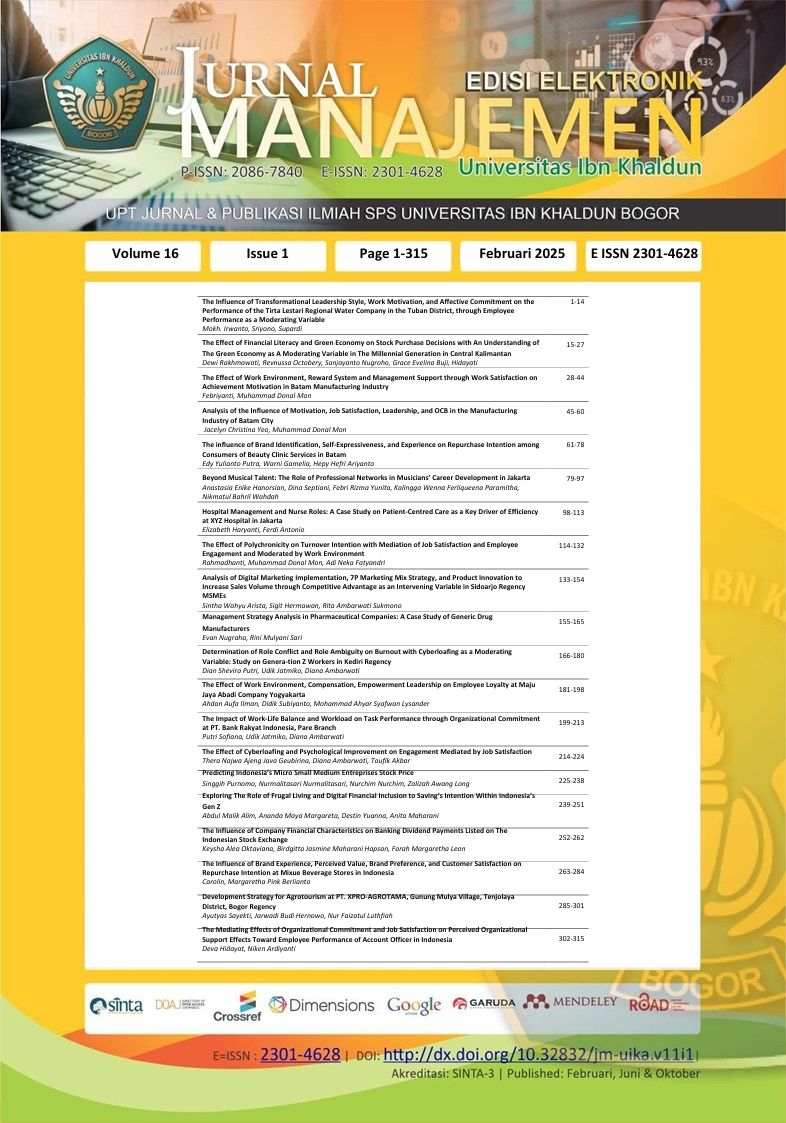Predicting Indonesia’s Micro Small Medium Entreprises Stock Price
DOI:
https://doi.org/10.32832/jm-uika.v16i1.17762Kata Kunci:
Indonesian MSMEs, Stock Price, Prediction, ARIMAAbstrak
The impact of stock prices on new enterprises, notably Micro, Small, and Medium Enterprises (MSMEs), in Indonesia is significant. Given the significance of stock prices for MSMEs, engaging in stock price forecasting is crucial. Several stock price forecast-ing models exist, but only a limited number are suitable for predicting stock prices using limited samples, such as the stock prices of MSMEs in Indonesia. The limited sample size is because MSMEs are newly established enterprises accessing stock prices. This study aims to predict MSME stock prices in Indonesia, namely SOUL and TGUK. The forecasting model utilized is ARIMA. The results suggest that the ARIMA (0,1,1) model provides the most precise forecast for the stock price of SOUL MSMEs, while the ARIMA (1,1,2) model yields the most outstanding performance for TGUK. Investors can use the forecast results to identify profit-able investment opportunities or protect their portfolios from po-tential losses. Moreover, companies can employ stock price pre-dictions to evaluate their performance, develop financial plans, and allocate resources.
Referensi
Aditi Singh, & Lavnika Markande. (2023). Stock Market Forecasting Using LSTM Neural Network. International Journal of Scientific Research in Computer Science, Engineering and Information Technology, 3307, 544–554. https://doi.org/10.32628/cseit23903138
Angeles, A., Perez-Encinas, A., & Villanueva, C. E. (2022). Characterizing Organizational Lifecycle through Strategic and Structural Flexibility: Insights from MSMEs in Mexico. Global Journal of Flexible Systems Management, 23(2), 271–290. https://doi.org/10.1007/s40171-022-00301-4
ASEAN Coordinating Comittee on MSMEs. (2023). Digitalisation of MSMEs in ASEAN and Russia Trends and Opportunities.
Barch, D. M. (2023). The Dangers of Small Samples and Insufficient Methodological Detail. Schizophrenia Bulletin, 49(1), 5–6. https://doi.org/10.1093/schbul/sbac137
D., S., Reddy, P. S., Vyshnevy, M., Tejasri, K., Akshaya, B., & Nikhil, P. (2024). Prediction and Analysis of Stock Markets Using ARIMA Models. In 2024 3rd International Conference on Computational Modelling, Simulation and Optimization (ICCMSO) (pp. 268–271). https://doi.org/10.1109/ICCMSO61761.2024.00061
Fattah, J., Ezzine, L., Aman, Z., El Moussami, H., & Lachhab, A. (2018). Forecasting of demand using ARIMA model. International Journal of Engineering Business Management, 10, 1–9. https://doi.org/10.1177/1847979018808673
Garner, S., Pan, Y., & Shi, M. (2024). Amazon’s Stock Trends Prediction based on ARIMA Model. Highlights in Business, Economics and Management, 35, 58–64. https://doi.org/10.54097/g3yrh896
Hassouna, F. M. A., & Al-Sahili, K. (2020). Practical Minimum Sample Size for Road Crash Time-Series Prediction Models. Advances in Civil Engineering, 2020. https://doi.org/10.1155/2020/6672612
Hwang, S. Y., & Basawa, I. V. (2004). Stationarity and moment structure for Box-Cox transformed threshold GARCH(1,1) processes. Statistics and Probability Letters, 68(3), 209–220. https://doi.org/10.1016/j.spl.2003.08.016
Iskandar, R., Azis, M., & Rahmat, N. (2019). Vaic mediated by financial performance and gcg increase stock prices. International Journal of Scientific and Technology Research, 8(12), 164–168.
Kaur, J., Parmar, K. S., & Singh, S. (2023). Autoregressive models in environmental forecasting time series: a theoretical and application review. Environmental Science and Pollution Research, 30(8), 19617–19641. https://doi.org/10.1007/s11356-023-25148-9
Kokol, P., Kokol, M., & Zagoranski, S. (2022). Machine learning on small size samples: A synthetic knowledge synthesis. Science Progress, 105(1), 1–16. https://doi.org/10.1177/00368504211029777
Kuang, S. (2023). A Comparison of Linear Regression, LSTM model and ARIMA model in Predicting Stock Price A Case Study: HSBC’s Stock Price. BCP Business & Management, 44, 478–488. https://doi.org/10.54691/bcpbm.v44i.4858
Latif, N., Selvam, J. D., Kapse, M., & Sharma, V. (2023). Comparative Performance of LSTM and ARIMA for the Short-Term Prediction of Bitcoin Prices. The Australasian Accounting Business and Finance Journal, 17(1), 256–276.
Li, Z. (2023). Research on the Performance of the ARIMA Model in the Stock Market. Advances in Economics, Management and Political Sciences, 46(1), 96–103. https://doi.org/10.54254/2754-1169/46/20230322
Liang, K., Wu, H., & Zhao, Y. (2024). Study of effectiveness of the Arima method in forecasting stock prices in China. In Proceedings of the 3rd International Conference on Computing Innovation and Applied Physics (Vol. 0, pp. 33–44). https://doi.org/10.54254/2753-8818/43/20240781
Liu, Z. (2022). A comparative research of portfolio return prediction based on the ARIMA and LSTM models. BCP Business & Management, 30, 388–396. https://doi.org/10.54691/bcpbm.v30i.2451
Pan, N., Xu, Q., & Zhu, H. (2021). The impact of investor structure on stock price crash sensitivity: Evidence from China’s stock market. Journal of Management Science and Engineering, 6(3), 312–323. https://doi.org/10.1016/j.jmse.2021.06.003
Pandey, A., Singh, G., Hadiyuono, H., Mourya, K., & Rasool, M. J. (2023). Using ARIMA and LSTM to Implement Stock Market Analysis. In 2023 International Conference on Artificial Intelligence and Smart Communication (AISC) (pp. 935–940). https://doi.org/10.1109/AISC56616.2023.10085405
Patwardhan, A. (2018). Financial Inclusion in the Digital Age. In Handbook of Blockchain, Digital Finance, and Inclusion, Volume 1: Cryptocurrency, FinTech, InsurTech, and Regulation (1st ed., Vol. 1, pp. 57–89). Elsevier Inc. https://doi.org/10.1016/B978-0-12-810441-5.00004-X
Pedraza, J. M. (2021). The Micro, Small, and Medium-Sized Enterprises and Its Role in the Economic Development of a Country. Business and Management Research, 10(1), 33. https://doi.org/10.5430/bmr.v10n1p33
Rana, G., & Choudhary, R. (2019). Micro Small and Medium Scale Enterprises - “Hidden and Helping Hand in Economic Growth.” SSRN Electronic Journal. https://doi.org/10.2139/ssrn.3354268
Tan, M. Y. J., & Biswas, R. (2012). The reliability of the Akaike information criterion method in cosmological model selection. Monthly Notices of the Royal Astronomical Society, 419(4), 3292–3303. https://doi.org/10.1111/j.1365-2966.2011.19969.x
Watson, P., & Nicholls, S. M. A. (1992). ARIMA modelling in short data sets: Some Monte Carlo results. Social and Economic Studies, 41(4), 53–75.
Wu, M., Huang, P., & Ni, Y. (2017). Investing strategies as continuous rising (falling) share prices released. Journal of Economics and Finance, 41(4), 763–773. https://doi.org/10.1007/s12197-016-9377-3
Xiao, R., Feng, Y., Yan, L., & Ma, Y. (2022). Predict stock prices with ARIMA and LSTM, 1–14. Retrieved from http://arxiv.org/abs/2209.02407
Zhang, B. (2023). The Stock Price Forecasting Based on Time Series Model and Neural Network. BCP Business & Management, 38, 3423–3428. https://doi.org/10.54691/bcpbm.v38i.4319
Zhang, Z., Zhang, Y., Zhang, X., & A, C. (2023). Stock Market Downturn and Stock Market Concentration. Journal of Economics, Finance and Accounting Studies, 152–163. https://doi.org/10.32996/jefas
Zhou, M., Shao, W., Liu, Y., & Yang, X. (2022). Field strength prediction based on deep learning under small sample data. Electronics Letters, 58(23), 857–859. https://doi.org/10.1049/ell2.12631
Unduhan
Diterbitkan
Cara Mengutip
Terbitan
Bagian
Lisensi
Hak Cipta (c) 2024 Jurnal Manajemen

Artikel ini berlisensi Creative Commons Attribution-NonCommercial 4.0 International License.
Authors who publish with this journal agree to the following terms:
- Authors retain copyright and grant the journal right of first publication with the work simultaneously licensed under a Creative Commons Attribution-NonCommercial-ShareAlike 4.0 International License that allows others to share the work with an acknowledgement of the work's authorship and initial publication in this journal.
- Authors can enter into separate, additional contractual arrangements for the non-exclusive distribution of the journal's published version of the work (e.g., post it to an institutional repository or publish it in a book), with an acknowledgement of its initial publication in this journal.
- Authors are permitted and encouraged to post their work online (e.g., in institutional repositories or on their website) prior to and during the submission process, as it can lead to productive exchanges, as well as earlier and greater citation of published work (See The Effect of Open Access).











